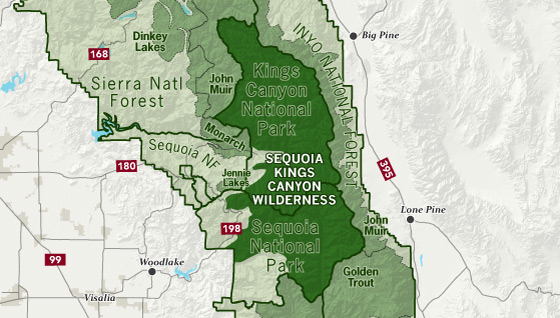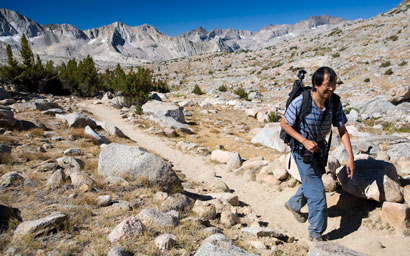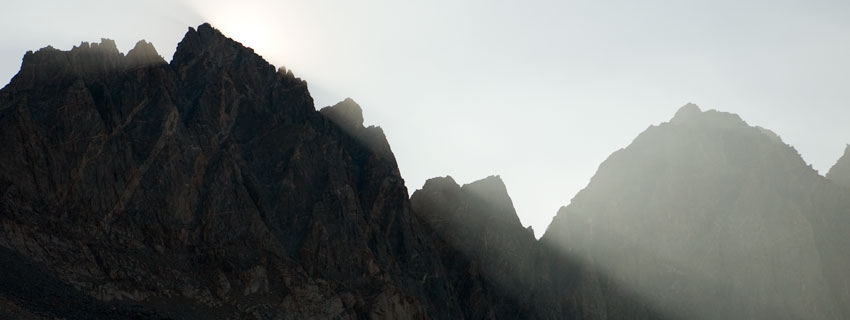
To the west, this wilderness descends to dry foothills of oak and chaparral toward the San Joaquin Valley. To the south runs the Middle Fork of the Kaweah River, as well as the Wild and Scenic North Fork of the Kern River. To the east stands the crest of the Sierra Nevada and the highest mountain in the Lower 48, Mount Whitney at 14,495 feet (shared with John Muir Wilderness).
Through the heart of this wilderness runs Kings Canyon at depths virtually unparalleled, prompting Muir to dub it “a rival to Yosemite.” It is cut by the Wild and Scenic South and Middle Forks of the Kings River, which flow out of the park to meet with the Wild and Scenic North Fork of the Kings River.

LeConte Canyon just after sunrise in the Sequoia-Kings Canyon Wilderness
GETTING THERE
The Sequoia-Kings Canyon and John Krebs Wildernesses encompass 93% (750,000 acres) of Sequoia and Kings Canyon National Parks. While many hikers enter the wilderness from the east side (along Hwy 395) crossing through the John Muir Wilderness, most visitors enter from the west using Hwy 180, 198, and 245. The parks maintain over 800 miles of trails. See the sidebar links for directions and public transportation options. Additional maps are here
WILDERNESS PERMITS
Wilderness permits are required for all overnight camping outside designated campgrounds in Sequoia and Kings Canyon National Parks. (Why)? There is a $15.00 backcountry camping fee for all parties late May through September. Permits are not required for day hikes, except in the Mt. Whitney area (entering through the Inyo National Forest). Free self-issue wilderness permits are required from October through late May.
Quotas limit the number of people entering each trailhead on a given day. To insure you’ve got a space, you can reserve a permit in advance from the National Park Service for trips between mid-May and September. Reservations can be made between March 1st and two weeks before the start of your intended trip. All reservation requests must be emailed (prefered), or mailed (see sidebar for additional information and links).
MAXIMUM GROUP SIZE
The maximum overnight group size is 15 people per party when traveling within 1/2 mile of maintained trails, and a maximum of 12 people for parties further than 1/2 mile of maintained trails. Some areas have lower limits. There is a maximum party size of 10 people in Redwood Canyon. There is a maximum party size of 8 people in the following areas: Colony Mill Road Trail, Don Cecil Trail, Darwin Canyon and Lamarck Col, Dusy Basin (further than 1/2 mile of maintained trails), Sixty Lakes and Gardiner Basins, Sphinx Lakes; Mount Whitney Management Area (further than 1/2 mile of maintained trails but including all of Mount Langley).
Stock party sizes are maximum of 15 people and 20 stock (total people and stock limited to 28) when traveling within 1/2 mile of maintained trails, and 12 people and 12 stock (total people and stock limited to 14) when traveling further than 1/2 mile of maintained trails in allowed areas. Some areas have lower limits: Redwood Canyon (10 people and 10 stock with total of 20), Upper Goddard Canyon (12 people and 12 stock with total of 14), and Sixty Lakes Basin and Miter Basin (total people and stock 8). If you plan to bring stock, be sure to check Sequoia and Kings Canyon’s stock use regulations.

Sunrise over one of the many lakes in Dusy Basin, Sequoia-Kings Canyon Wilderness
CAMPFIRES
KINGS CANYON NATIONAL PARK
Wood fires are permitted in Kings Canyon National Park below 10,000 feet elevation except in Granite Basin and Redwood Canyon.
SEQUOIA NATIONAL PARK - KAWEAH AND TULE RIVER DRAINAGES
Fires are permitted in the Kaweah and Tule River Drainages of Sequoia National Park below 9000 feet elevation except at Hamilton Lakes, Pinto Lake, and Mineral King Valley.
SEQUOIA NATIONAL PARK - KERN RIVER DRAINAGE
Fires are permitted in the Kern River Drainage of Sequoia National Park below 10,000 ft elevation
In places where fires are allowed, make sure to always follow smart campfire guidelines.
BEARS AND FOOD STORAGE
Sequoia and Kings Canyon National Parks strongly recommend that all campers carry all food, garbage, and toiletries in a park-allowed bear-resistant food-storage container. These parks are making a concerted effort to remove broken and unused lockers from the wilderness. The map of bear box locations is from 2015, and information is subject to rapid and unannounced change.
This recommendation is in addition to the existing requirements to carry and use park-allowed, bear-resistant food-storage containers in three specified areas: 1) Rae Lakes Loop and vicinity 2) Dusy and Palisades Basins and 3) Rock Creek drainage.
To learn more check out:
- Map of required canister areas and bear box locations
- SierraWild.Gov Bear Section
- Canister rental information
PETS
Pets are not allowed in the Sequoia-Kings Canyon or John Krebs Wildernesses. As a rule of thumb, pets are usually not allowed away from developed areas in National Parks. If you plan to hike or backpack during your visit, best to leave your dog elsewhere during your trip.

Photographer Quang Tuan Luong hiking toward Bishop Pass in the Sequoia-Kings Canyon Wilderness ~ Photo: Lincoln Else
